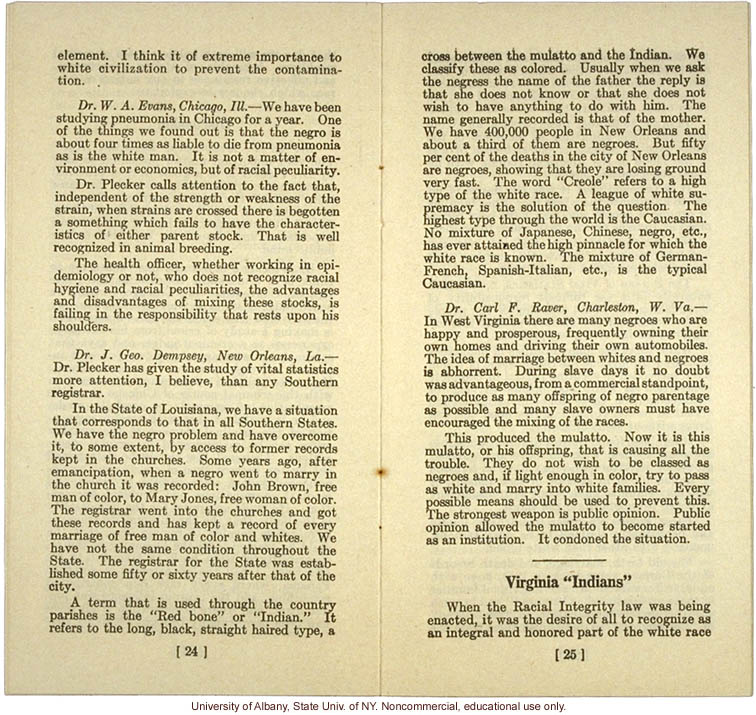[left side]
element. I think it of extreme importance to white civilization to prevent the contamination.
Dr. W. A. Evans, Chicago, Ill. - We have been studying pneumonia in Chicago for a year. One of the things we found out is that the negro is about four times as liable to die from pneumonia as is the white man. It is not a matter of environment or economics, but of racial peculiarity.
Dr. Plecker calls attention to the fact that, independent of the strength or weakness of the strain, when strains are crossed there is begotten a something which fails to have the characteristics of either parental stock. That is well recognized in animal breeding.
The health officer, whether working in epidemiology or not, who does not recognize racial hygiene and racial peculiarities, the advantage and disadvantages of mixing these stocks, is failing in the responsibility that rests upon his shoulders.
Dr. J. Geo. Dempsey, New Orleans, La. -Dr. Plecker has given the study of vital statistics more attention, I believe, than any Southern registrar.
In the State of Louisana, we have a situation that corresponds to that in all Southern States. We have the negro problem and have overcome it, to some extent, by access to former records kept in the churches. Some years ago, after emancipation, when a negro went to marry in the church it was recorded: John Brown, free man of color, to Mary Jones, free woman of color. The registrar went into these churches and got these records and has kept a record of every marriage of free man of color and whites. We have not the same condition throughout the State. The registrar for the State was established some fifty or sixty years after that of the city.
A term that is used through the country parishes is the "Red bone" or "Indian." It refers to the long, black, straight haired type, a
[24]
[right side]
cross between the mulatto and the Indian. We classify these as colored. Usually when we ask the negress the name of the father the reply is that she does not know or that she does not wish to have anything to do with him. The name generally recorded is that of the mother. We have 400,000 people in New Orleans and about a third of them are negroes. But fifty per cent of the deaths in the city of New Orleans are negroes, showing that they are losing ground very fast. The word "Creole" refers to a high type of the white race. A league of white supremacy is the solution of the question. The highest type through the world is the Caucasian. No mixture of Japanese, Chinese, negro, etc., has ever attained the high pinnacle for which the white race is known. The mixture of German-French, Spanish-Italian, etc., is the typical Caucasian.
Dr. Carl F. Raver, Charleston, W. Va. - In West Virginia there are many negroes who are happy and prosperous, frequently owning their own homes and their own automobiles. The idea of marriage between whites and negroes is abhorrent. During slave days it no doubt was advantageous, from a commercial standpoint, to produce as many offspring of negro parentage as possible and many slave owner must have encouraged the mixing of the races.
This produced the mulatto. Now it is this mulatto, or his offspring, that is causing all the trouble. They do not wish to be classed as negroes and, if light enough in color, try to pass as white and marry into white families. Every possible means should be used to prevent this. The strongest weapon is public opinion. Public opinion allowed the mulatto to become started as an institution. It condoned the situation.
[centered score]
Virginia "Indians"
When the Racial Integrity law was being enacted, it was the desire of all to recognize as an integral and honored part of the white race
[25]
[end]


